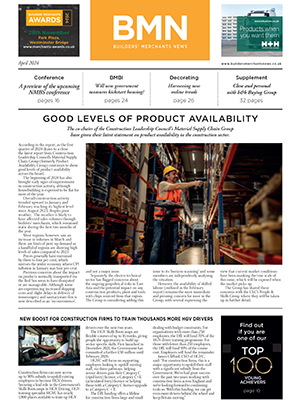Dunlop’s Debi Boulton reveals her prediction for 2014’s tiling trend.
The UK has had a wet winter and, as a result, homeowners are now looking at paying more attention to their outdoor space as the dry weather comes in. Last summer saw a 38% leap in the sale of garden furniture, as Britons splashed the cash in a bid to spruce up their gardens and terraces. It may only be spring, but it’s important for professional builders and builders’ merchants to take note of these trends and plan for the year ahead.
One sought-after look in 2013 – and one we predict will become increasingly popular throughout 2014 – is external wall and floor tiling. Here’s a step-by-step guide to achieving this contemporary style for your customers.
Blowing hot and cold
The first consideration for external wall and floor tiling should always be the environment and temperature to which a substrate is applied. In outdoor environments it’s essential for professional builders to allow sufficient time for substrates to dry, fully cure, and ensure that planning includes time for adverse weather conditions. This is to make sure that tiling is protected from changing environmental conditions until the adhesive and grout is fully dry. Professional builders should also consider the following:
- The background tile and adhesive must be able to withstand changing weather conditions. Exposure to thermal effects, water penetration, pollution and frost should also be considered
- Tiling should not be carried out during periods of extremely high or low temperatures. If such conditions occur after tiling has commenced, the operation should be suspended until the conditions improve or adequate precautions have been taken
- The approximate temperature range for satisfactorily carrying out the installation, with normal methods and materials, is 5°C to 25°C (taking into account prevailing humidity levels and the degree of air movement)
- Any areas of potential water penetration must be protected. This is in order to prevent ingress from water and waterborne dirt/contamination behind the tiling
- Generally, tiling cannot be undertaken satisfactorily on backgrounds having temperatures in excess of 40°C. The effects of temperature variation on these tile installations, such as shrinkage or expansion, should be taken into account. When the prevailing temperature is outside this range, precautions are necessary to enable work to proceed
- It’s also important to consider the background structure, as it can act as heat or cold sinks and might not reach suitable working temperatures for some time after corrective steps have been taken. In addition, where hot conditions prevail, it might be necessary to modify bedding techniques to avoid the drying or skinning over of bedding material in the interval between application of the bed and the positioning of the tiles.
A lasting finish
When considering outdoor tiling work, as well as weather resistance, there are other points to consider when it comes to achieving a lasting finish for customers:
- Wherever tiling is undertaken with a standard adhesive (setting time between 16 to 24 hours) then individual tiles should be supported so they are not put under undue strain
- When fixing smaller ceramic tiles up to a first-storey height or when using mosaics, no special consideration is normally required for mechanical fixing. However when considering the use of larger-format ceramic tiles, natural stone tiles or slabs, further advice must be sought from the Dunlop technical advice line
- For mesh-backed mosaics, the backing material and its adhesive should not occupy more than 25% of the area of each tesserae; the critical factor is the spread of the adhesive over the backs of the tesserae. The backing material and its adhesive must not deteriorate in service and must be compatible with the mortar or adhesive bed, in accordance with the mosaic manufacturer’s instructions
- Last but not least, when tiling using large-format tiles – 300mm x 300mm or larger – mechanical fixing should always be used.
Get on board
Plasterboard, fibre-building board, plywood and wood chipboard should not be used as backgrounds for tiling and mosaics in external situations. Some proprietary sheets and boards that are dimensionally stable in changing moisture conditions are suitable for use on walls as a backing for external wall tiling. Confirmation should be obtained from the manufacturer on the suitability for the height of the installation, as well as the weight of tiling and degree of exposure to the weather.
Such proprietary sheets and boards should be fixed in accordance with the manufacturer’s instructions to provide a rigidly supported surface suitable to receive ceramic tiling. Sealing the back and edges of the board with a bonding agent, such as Dunlop’s Universal SBR Bonding Agent, will help to improve strength.
Durability
To lessen the risk of adhesion failure or tiles cracking due to structural movement or drying shrinkage, movement joints should be incorporated in the installation as follows:
- Movement joints in external wall tiling should be incorporated as outlined in British Standards (BS 5385: Part 2: 2006, clause 10). This document requires that joints be located over existing movement joints
- Where tiling abuts other materials, at junctions between different background materials (when cladding is continuous across varying types)
- At external angles vertically within 0.25m to 1m from the angle and also at storey heights horizontally and approximately 3m to 4.5m apart vertically. Ideally, these joints should be located over movement joints in the structural background and at structural material changes. Care should also be taken to ensure that the joints are properly formed and extend through the tile, bed and rendering, and are a minimum of 6mm wide. The joints may be filled with a suitable sealant to ensure a stronger hold
Time to apply
Once a sound flat interface has been achieved, it’s time to apply the suitable, fully vitrified, or frost-resistant tiles to a solid bed of adhesive. It’s important that there are no voids beneath the tile as these will allow water to collect, which could freeze and expand, causing the tiles to crack.
Preferably, tiling should begin from the highest point of the building, however where standard adhesives are used then tiling should begin from the base of the top floor, and then proceed around the circumference of the building, allowing the adhesive to dry before proceeding to the next row to ensure there is no slumping.
A highly polymer modified cement based tile adhesive should be used on walls and floors. The working and setting time of the tile adhesive will vary with the outdoor temperature. In high temperatures this time period will be reduced, and in colder conditions it will increase.
Finishing touches
The grouting should be carried out as soon as possible after fixing to ensure that the joints are kept free from dust or any other deleterious material. To further enhance the physical and mechanical properties of grout, professional builders can also use a flexible additive. After completion, all tiling should be protected for as long as possible with plastic sheeting or a similar material.
The most important consideration when looking to install external floor and wall tiling is to remember that although this contemporary style is in high demand with homeowners, it often involves a tricky installation process. External tiling installations are potentially dangerous, particularly above first-storey heights, therefore it’s crucial that professional builders are well informed before they start on a job.
For full support on external tiling, please contact Dunlop’s dedicated technical helpline on 01782 591160.
Debi Boulton is brand manager of Dunlop.







